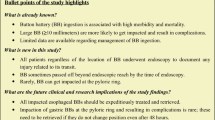Abstract
Button battery (BB) impaction in the esophagus requires immediate endoscopic removal and meticulous follow-up, including serial cross-sectional imaging, preferably with magnetic resonance imaging (MRI). However, BBs quickly degrade in the esophagus, and metallic fragments may remain in the injured mucosa following removal. This metallic debris can cause thermal injury during MRI, potentially aggravating local injury. We aimed to explore whether such metallic fragments could be identified on imaging following BB removal. In this study, we conducted a retrospective review of children (0–18 years) presenting with BB impaction in the esophagus between 2014 and 2020. Endoscopy reports and imaging studies were blindly reviewed by a pediatric gastroenterologist and a pediatric radiologist. Of 161 cases of battery ingestion, 14 (8%) underwent endoscopy, and in 9 (5%) a BB was impacted in the esophagus. The median time from ingestion to BB removal was 8 h (range 2–48 h). The median time from removal to CT was 44 h (range 0.5–104 h). BB appearance ranged from mild corrosion to visible debris. Pre-removal plain films showed irregular battery contour suggesting corrosion (5/7 plain films). In 7/9 CT scans (78%), high-attenuation esophageal content (median 266HU (range 140–1151)), which may represent metallic debris, was identified. Five patients had a follow-up CT which still showed gradual resolution of the high-attenuation content.
Conclusions: we describe a new finding on CT following BB removal which might represent metallic debris. Clinicians should be aware of these findings which potentially may be harmful during MRI used in the ongoing assessment of esophageal injury.
What is Known: • Button batteries are a dangerous pediatric foreign body with potentially fatal vascular complications. | |
What is New: • Metallic debris was identified on computerized tomography following button battery removal in most children. • We bring to attention this new finding which may affect clinical management, as minimal metallic content can cause burns during MRI. |


Similar content being viewed by others
Availability of data and materials
Data will be kept at the corresponding author’s facility and will be available upon request.
Abbreviations
- BB:
-
Button batteries
- CT:
-
Computerized tomography
- HU:
-
Hounsfield units
- MRI:
-
Magnetic resonance imaging
References
Brumbaugh DE, Colson SB, Sandoval JA et al (2011) Management of button battery-induced hemorrhage in children. J Pediatr Gastroenterol Nutr 52(5):585–589. https://doi.org/10.1097/MPG.0b013e3181f98916
Litovitz T, Whitaker N, Clark L, White NC, Marsolek M (2010) Emerging battery-ingestion hazard: clinical implications. Pediatrics 125(6):1168–1177. https://doi.org/10.1542/peds.2009-3037
Mubarak A, Benninga MA, Broekaert I et al (2021) Diagnosis, management, and prevention of button battery ingestion in childhood: an ESPGHAN position paper. J Pediatr Gastroenterol Nutr. https://doi.org/10.1097/MPG.0000000000003048
Leinwand K, Brumbaugh DE, Kramer RE (2016) Button battery ingestion in children: a paradigm for management of severe pediatric foreign body ingestions. Gastrointest Endosc Clin N Am 26(1):99–118. https://doi.org/10.1016/j.giec.2015.08.003
Battery Ingestion Triage and Treatment Guideline (2018) www.poison.org/battery. Accessed November 5, 2020
Riedesel EL, Richer EJ, Sinclair EM et al (2020) Serial MRI findings after endoscopic removal of button battery from the esophagus. Am J Roentgenol 215(5):1238–1246. https://doi.org/10.2214/AJR.19.22427
Adam A, Dixon AK, Grainger RG, Allison DJ (2008) Grainger & Allison’s Diagnostic Radiology: A Textbook of Medical Imaging
Magnetic Resonance Imaging - Benefits and Risks, U.S. Food and Drug Administration. https://www.fda.gov/radiation-emitting-products/mrimagnetic-resonance-imaging/benefits-and-risks. Accessed December 21, 2020
Shellock FG, Kanal E (1996) Burns associated with the use of monitoring equipment during MR procedures. J Magn Reson Imaging 6(1):271–272. https://doi.org/10.1002/jmri.1880060150
Wagle WA, Smith M (2000) Tattoo-induced skin burn during MR imaging. Am J Roentgenol 174(6):1795. https://doi.org/10.2214/ajr.174.6.1741795
Tokue H, Tokue A, Tsushima Y (2019) Unexpected magnetic resonance imaging burn injuries from jogging pants. Radiol Case Reports 14(11):1348–1351. https://doi.org/10.1016/j.radcr.2019.08.015
Pugmire BS, Lin TK, Pentiuk S, de Alarcon A, Hart CK, Trout AT (2017) Imaging button battery ingestions and insertions in children: a 15-year single-center review. Pediatr Radiol 47(2):178–185. https://doi.org/10.1007/s00247-016-3751-3
Sainani NI, Gervais DA, Mueller PR, Arellano RS (2013) Imaging after percutaneous radiofrequency ablation of hepatic tumors: part 1, normal findings. Am J Roentgenol 200(1):184–193. https://doi.org/10.2214/AJR.12.8478
Rajesh S, Mukund A, Arora A (2015) Imaging diagnosis of splanchnic venous thrombosis. Gastroenterol Res Pract. https://doi.org/10.1155/2015/101029
Orwig D, Federle MP (1989) Localized clotted blood as evidence of visceral trauma on CT: the sentinel clot sign. Am J Roentgenol 153(4):747–749. https://doi.org/10.2214/ajr.153.4.747
Lev MH, Gonzalez RG (2002) CT Angiography and CT perfusion imaging. In: Brain mapping: the methods. Elsevier :427–484. https://doi.org/10.1016/b978-012693019-1/50019-8
KM K (1995) Apoptosis and calcification. Scanning Microsc. 9(4):1137–1178
Metterlein T, Haubner F, Knoppke B, Graf B, Zausig Y (2014) An unexpected ferromagnetic foreign body detected during emergency magnetic resonance imaging: a case report. BMC Res Notes 7(1):808. https://doi.org/10.1186/1756-0500-7-808
Grey NEO, Malone LJ, Miller AL et al (2021) Magnetic resonance imaging findings following button battery ingestion. Pediatr Radiol. 1–11. https://doi.org/10.1007/s00247-021-05085-w
McCollough CH, Leng S, Yu L, Fletcher JG (2015) Dual- and multi-energy CT: Principles, technical approaches, and clinical applications. Radiology 276(3):637–653. https://doi.org/10.1148/radiol.2015142631
Author information
Authors and Affiliations
Contributions
Dr Yogev and Dr Cytter-Kuint conceptualized and designed the study, collected the data, performed the data analysis, reviewed the literature, and drafted and revised the manuscript, Dr Lev-Tzion contributed to the study design and interpretation and analysis of data and revised the initial draft and final manuscript, Dr Ledder, Dr Orlanski-Meyer, and Dr Zharkov contributed to the study design, acquisition of data, interpretation of the results, and revision of the manuscript. All the authors approved the final manuscript as submitted and agreed to be accountable for all aspects of the work.
Corresponding author
Ethics declarations
Ethics approval
The study was approved by the institutional IRB committee.
Conflict of interest
The authors declare no competing interests.
Additional information
Communicated by Peter de Winter
Publisher's Note
Springer Nature remains neutral with regard to jurisdictional claims in published maps and institutional affiliations.
Rights and permissions
About this article
Cite this article
Yogev, D., Lev-Tzion, R., Ledder, O. et al. Retained metal fragments following esophageal button battery impaction. Eur J Pediatr 181, 143–147 (2022). https://doi.org/10.1007/s00431-021-04184-y
Received:
Revised:
Accepted:
Published:
Issue Date:
DOI: https://doi.org/10.1007/s00431-021-04184-y




